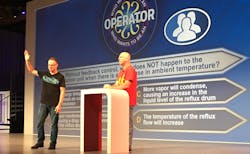Though cybersecurity is an important issue to address, Honeywell Process Solutions (HPS) President Vimal Kapur suggested that new workforce development is an even bigger challenge. “Cybersecurity is a technical problem, and we’ve always been able to solve technical problems,” he said at Honeywell Users Group (HUG) 2016. But how do we transfer knowledge from retiring people?
We often hear from experienced workers about the negative traits of Millennials entering the workforce. But the experts at HUG 2016 spoke about both the pros and cons they see in the upcoming generations; for example: they are enthusiastic and tech-savvy, but tend to change jobs quickly. The experts also addressed how companies can align Millennials’ work styles with optimized plant performance.
Kapur suggested that this transition poses two main challenges. First, employers must have the right technology to enable sustained or improved performance. In the past, it often took 2 to 5 years (or more) to upgrade technology in industrial operations. Adoption and upgrades must happen faster to keep workers engaged and working efficiently. Second, employers must answer the question of how to get new workers to a skilled state more quickly.
Millennial work styles and preferences are driving HPS’s approach to training and tools. Many Millennials expect state-of-the-art technology and feel that access to the right technology increases their efficiency. They sleep with their phones, but also start cars and buy coffee with them. It makes sense to allow people to do their jobs with technology they are used to. Applications like Honeywell Pulse allow employees to connect with the process through global and personalized alerts and watchlists. Troubleshooting also becomes more efficient with text, images and videos. A maintenance technician can send video of a leak in the field to a supervisor, so decisions can be made in real-time without additional trips.
As a whole, electronic communication is preferred over phone or in-person meetings. Employees can use tools like Movilizer to digitize and historize records from the field or floor, and interface with ERPs or other systems. Dashboards in the Terminal Automation mobile app show a broad view when managing multiple terminals, so people can identify underutilization and maximize throughput without big meetings or communicating to request data.
With an average company tenure of two years, “loyalty-lite” Millennials change jobs more quickly than previous generations. “You can buy all this gear, but are [the workers] ready for it?” asked Kapur. Often, the process of onboarding and reaching the desired competency level takes two years, but the cycle time to reach competency must become faster.
HPS has developed sophisticated competency assessment tools as part of the UniSim Competency Suite to retain knowledge in the workforce as seasoned employees retire. UniSim Tutor, a game-like tool in the suite, teaches users through its Diagnose and What-If evaluation methods based on plant-specific scenarios.
To illustrate the point, Chief Technology Officer Bruce Calder hosted a quick round of “Who Wants to be an Operator?” (a version of the popular “Who Wants to Be a Millionaire” game show) during his presentation. Though the contestant answered incorrectly, the value was clear. “Even if you get it wrong, in the process of answering the question, you learned the right answer,” said Calder. The tool doesn’t just assess knowledge, it trains people.
The work environment has to align with the people in the plant. It simply doesn’t make sense to force a generation to adapt to outdated technology. HPS is making the most of the changing workforce, interconnecting smart devices, controllers and people to optimize industrial assets and processes.
About the Author

Leaders relevant to this article:
